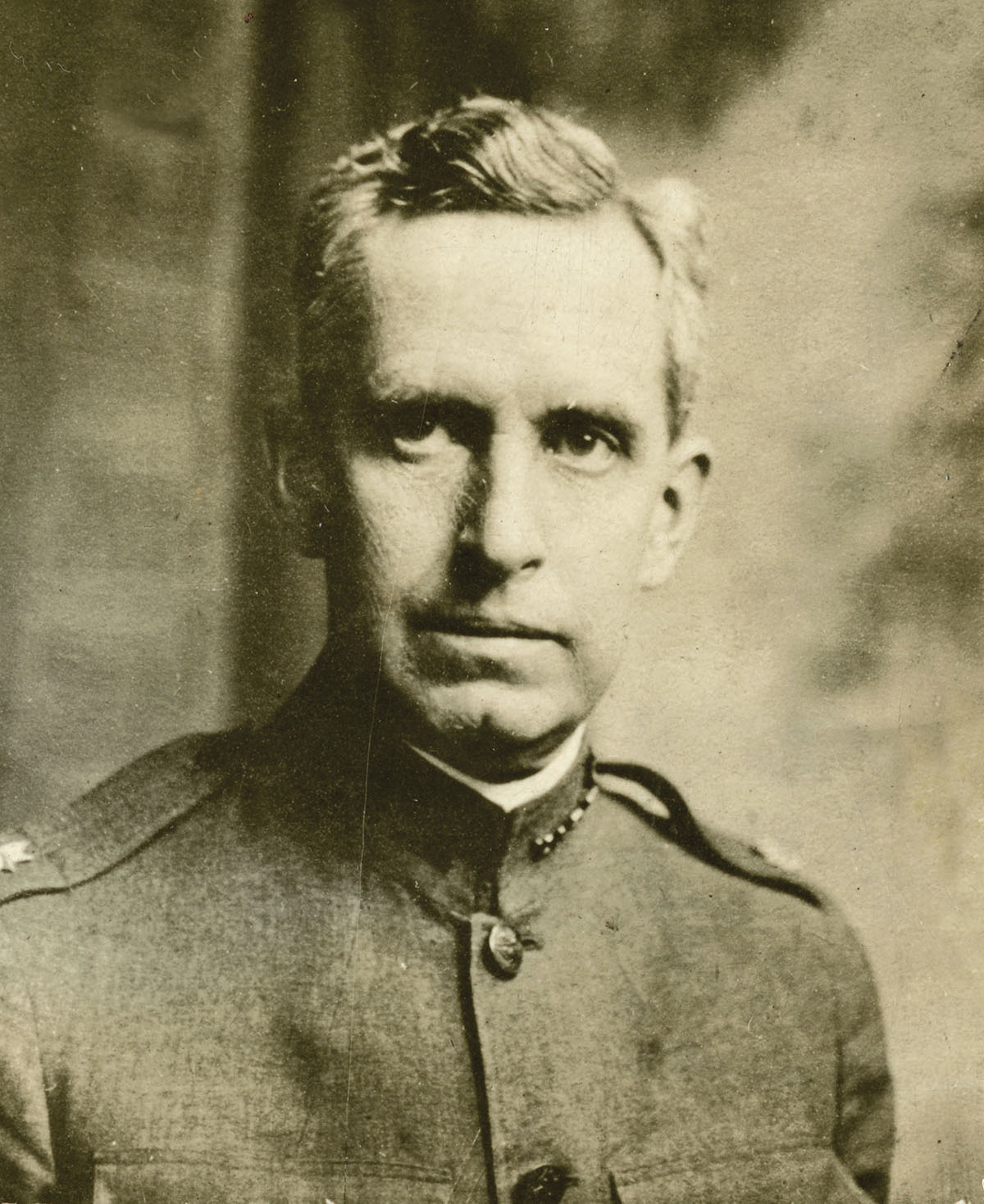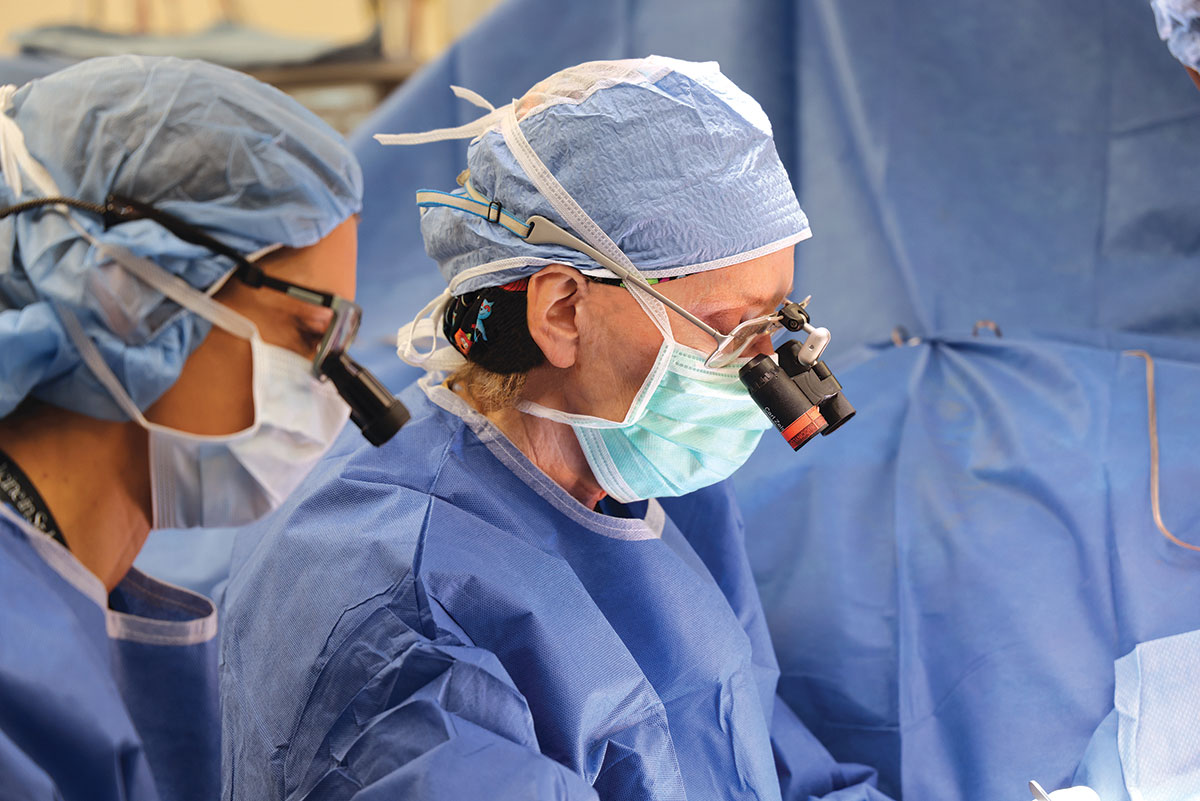IN NERVE TRANSFER SURGERY, THE SURGEON IDENTIFIES A HEALTHY, EXPENDABLE NERVE LOCATED NEAR THE SITE OF NERVE INJURY. THIS ADJACENT NERVE IS TRANSFERRED AND SEWN TO THE DAMAGED NERVE, CLOSE TO THE MUSCLE.
Illustration courtesy of Maury Aaseng
BY TIM FOX
Plastic surgery and neuroscience advance through trauma.
Severe burns, car accidents, war—these and other tragedies push plastic and reconstructive surgeons beyond the limits of collective wisdom to change patients’ lives.
For example: If you consider the history of plastic and reconstructive surgery, you’ll find that both world wars helped hone the skills of surgeons who, after the war, returned home and further refined their skills, helping to build the field. One such surgeon, Vilray Papin Blair, led the Section of Oral and Plastic Surgery in the U.S. Army during World War I. He and his team specialized in repairing complex craniofacial injuries sustained during battle. After the war, Blair joined the faculty at Washington University School of Medicine and began building a world-class department of plastic and reconstructive surgeons.
Other early pioneers in surgery and reconstructive surgery practicing in the United States and Europe include John Peter Mettauer (first cleft palate surgery, 1827), Sir Harold Gillies (new method of facial reconstruction, 1917) and James Barrett Brown (groundbreaking facial reconstruction, c. 1944).

VILRAY PAPIN BLAIR, SECTION OF ORAL AND PLASTIC SURGERY, U.S. ARMY, JOINED THE FACULTY AT WASHU MEDICINE AFTER WORLD WAR I, USING THE SKILLS HE GAINED DURING HIS SERVICE TO ADVANCE HIS FIELD OF MEDICINE.
Photo courtesy of WashU Medicine Bernard Becker Medical Library
The list of surgeons to have significantly advanced the field would have to include Susan Mackinnon, MD, WashU Medicine plastic and reconstructive surgeon at Barnes-Jewish Hospital.
Mackinnon joined the WashU Medicine faculty in 1991. Founder of the Division of Plastic and Reconstructive Surgery Center at WashU Medicine and its first director, Mackinnon has dedicated her life to developing, refining and expanding a surgical technique called nerve transfer.
A first step, then another
Mackinnon’s career stands as an apt illustration of the concept known as “paradigm shift.” A phrase popularized by science philosopher Thomas Kuhn’s 1962 book titled The Structure of Scientific Revolutions, paradigm shift describes how science advances only after long struggles against received knowledge.
“Innovation is mini steps—one step, one step, one step,” Mackinnon explains. “You start with an idea and pursue it, but if it fails, it moves you toward another, better idea. Once you have found something important, you share it with others.
“You seek out early adopters and, once you’ve convinced 14 to 20% of people that you’re right, change begins to happen; you can’t stop it. But this process takes years, and it isn’t an easy path.”
Mackinnon, a native of Canada, says that her passion for neuroscience began when she was a pre-med student at Queens University in Kingston, Ontario. One afternoon, she attended a lecture by neurosurgeon Harry Botterell, MD, dean of the Queens University School of Medicine.

SUSAN MACKINNON, MD, AN INNOVATOR IN HER FIELD, PERFORMS NERVE TRANSFER SURGERY.
Photo courtesy of WashU Medicine
“During World War II, Botterell was the senior neurosurgeon at what was then No. 1 Neurological Hospital, located in Basingstoke, England,” Mackinnon recalls. “In his lecture, he discussed aspects of spinal cord injury. I found it fascinating.”
Her interest caused her to choose every elective course on nerves that was available. By 1981, she had completed her general surgical training at Queens, a residency in plastic surgery at the University of Toronto and a research fellowship in that university’s Division of Neurosurgery. When her fellowship work at the Curtis Hand Center in Baltimore concluded in 1982, Mackinnon’s focus on nerve surgery was set.
Establishing a practice at University of Toronto’s trauma center, Mackinnon treated a variety of nerve-related conditions, including pressure sores for patients with spinal cord injuries. “The treatment for a pressure sore at that time was to cover it with a flap of skin taken from the thigh,” Mackinnon says. But the flap had no sensation, no nerve activity and eventually was no longer viable—and the process would have to be repeated. “It was difficult process for the patient and the surgeon.”
Seeking a better solution, Mackinnon decided she wanted to try to restore sensation to these flaps. To accomplish this, she says, “I tunneled a sensory nerve from the arm to a position along the side of the chest and connected it to a sensory nerve in the thigh flap.” Only after sensation had been restored to the flap of skin was it transferred to cover the sore. Because the flap now had working nerves, it offered a greatly improved solution to the problem.
Though the term didn’t exist yet, this surgery was an early version of a technique now called nerve transfer. Unlike nerve autograft, in which a surgeon removes a functioning nerve segment from one part of the body and moves it to another part to replace a damaged nerve, nerve transfer connects the damaged nerve to a nearby nerve that has a similar function.
While at the trauma center, Mackinnon also treated many people with compression injuries, including severe carpal tunnel syndrome. She began wondering if it would be possible to work within the nerves to ease the pressure between bundles of nerve fibers, but she faced a challenge. At that time, in the early 1980s, most surgeons avoided even touching a nerve, let alone opening its layers and working inside of it, a process called neurolysis.
Using rates to model the procedure, Mackinnon initially faced disappointing results. But she also noted that the procedure itself caused no harm. Having proven that working within a nerve was safe, she began creating topographical maps of nerve function.
“There are just no words to describe what it’s like to build a map that shows exactly where individual nerve fibers go and what they do,” she says, noting the elegance and complexity of the nervous system. “No words.”
In another step forward, Mackinnon and her mentor, Alan Hudson, MD, University of Toronto’s chair of neurosurgery, performed the first allograft—the transfer of a nerve from a cadaver to a patient. Encouraged by their success, Hudson and Mackinnon made plans to open a multidisciplinary nerve center in Toronto. However, word of Mackinnon’s astonishing breakthroughs had reached WashU Medicine, and it soon approached Mackinnon about becoming a member of its faculty.
Defining and refining
Shortly after accepting her new position, Mackinnon accelerated her work on nerve transfer, aided by neuroscientists Joshua Sanes, PhD, and Jeff Lichtman, MD, PhD, both now at Harvard University. In Mackinnon’s lab, this team created a rat model that showed, via fluorescence, how signals move across a nerve transfer. This and other research in Mackinnon’s lab helped further refine the nerve transfer technique. Along the way, she shared her knowledge with colleagues.
As a result, additional advances became possible, including the ability to broaden the use of nerve transfer to include most types of nerve injury. Alison Snyder-Warwick, MD, WashU Medicine plastic and reconstructive surgeon at Barnes-Jewish Hospital, now performs nerve transfer surgery to reanimate facial muscles and return sensation to corneas to protect vision. Thomas Tung, MD, WashU Medicine plastic and reconstructive surgeon at Barnes-Jewish Hospital, uses nerve transfer in lower extremities, most notably in a procedure that restores knee extension. Mackinnon herself made history by restoring hand function to a person with a spinal cord injury and paralysis.
INNOVATION IS MINI STEPS—ONE STEP, ONE STEP, ONE STEP
In the mid-1990s, Mackinnon met Ida Fox, MD, then a surgical resident from Rochester, New York. Fox was interested in collaborating with Mackinnon on research and worked for two years in her lab. Now a WashU Medicine plastic and reconstructive surgeon at Barnes-Jewish Hospital, Fox is moving Mackinnon’s work forward by building an international reputation in nerve transfer surgery for people with spinal cord injuries.
Hard work, perseverance, then joy
It took Mackinnon more than a decade of research and patient care at the University of Toronto and another 30-some years at WashU Medicine to reach the level of success she had hoped nerve transfer surgery would achieve.
It’s worth noting, however, that like the development of the procedure itself, the results of nerve transfer may seem miraculous—movement is restored where once there was none—but they are not instantaneous.
Fox says that during the procedure, the surgeon selects a nerve that has a function also performed by other nerves, then switches it to join with the injured nerve. “But it can take two years or more for a connection to occur,” she adds. During that time, the patient must work to retrain the brain to recognize and adapt to the transferred nerve’s new function. “That process takes a positive outlook and rigorous physical therapy, but the results are life-changing,” Fox says.
Despite the work involved, Mackinnon says, “nerve transfer gives joy to patients, to everyone who loves them.” Where movement was impossible, it once again becomes possible.
Joy is an essential part of Mackinnon’s work today. In addition to performing nerve transfer surgery and training students and surgeons, she also coaches medical students and others to help them find joy in their work.
“When you figure out what you are here to do, then place your trust in that and start doing it, the endorphins will start to flow,” Mackinnon says. “You’ll have ups and downs, but trusting in what you are doing will soften the blows and distractions so that you can continue to imagine, create and innovate.”
Mackinnon now finds joy in helping patients across the country and around the world, while also sharing her knowledge with students and surgeons.
“At WashU Medicine alone, she’s trained great hand and nerve surgeons, including Dr. Ida Fox, Dr. Thomas Tung, Dr. Alison Snyder-Warwick, Dr. Amy Moore, Dr. Zachary Ray and many others,” says Justin Sacks, MD, chief of WashU Medicine’s Division of Plastic and Reconstructive Surgery. “These specialists, in turn, disseminate their knowledge, further advancing the field.”
Videos of Mackinnon’s nerve transfer procedure—and her lectures on the topic—live online, making it possible to reach more people and change more lives. At a recent medical conference, a surgeon from Athens, Greece, noted that after watching the videos, he and his team hear Mackinnon’s voice in their heads when performing nerve transfer, which helps guide them to success.